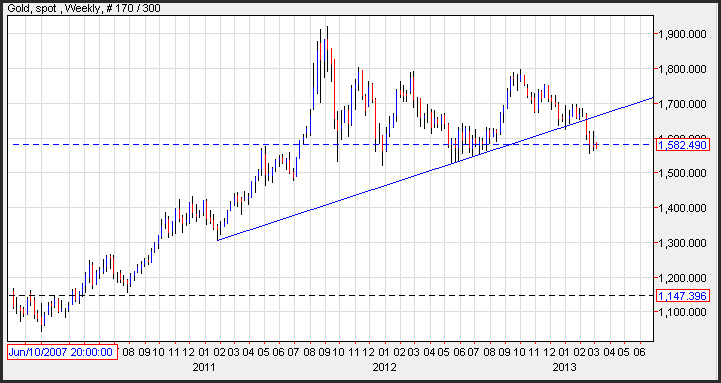Several weeks ago, the spot gold commodity broke down below major support of a multi-year uptrend line. Now, gold is hanging around near horizontal price support of its 2012 lows. On our internal watchlist as a potential short sale if it bounces into new resistance of its prior uptrend line, SPDR Gold Trust ($GLD) could be headed for a more significant, intermediate to long-term correction.
In the following article, a guest post from Marcus Holland, learn about some of the basic fundamental aspects of gold that could be driving factors behind the technical trend reversal.
Has gold lost its panache’ as an investment?
The financial exchanges are driven much more by psychological forces than financial factors, which has clearly been established over the centuries. As John Maynard Keynes counseled, “the markets can remain irrational a lot longer than you can stay solvent.”
That has been happening with those long on gold for about the past 18 months.
This should be a golden period for The Yellow Metal. Central bankers around the world are debasing fiat currencies with rounds of quantitative easing, resulting in trillions of government bonds being purchased and swapped. Why do central bankers trade trillions of their own government bonds?
Easy: because no one else will purchase the government debt issued by the United States, Japan and others at such prevailing low interest rates.
From these actions by central bankers, gold should still be soaring in price. But instead, The Yellow Metal is now testing critical horizontal price support around the $1540 to $1580 level, after recently breaking down below support of a multi-year uptrend line (see chart below).
If gold convincingly breaks down below the 2012 low of $1541, bearish momentum could send the price sharply lower. Even Bullionvault are tweeting “#GLD sees longest ever run of #gold outflows https://goo.gl/W15ij Technical picture ‘remains poor’ for gold and #silver.”
What happened to the coolness of gold?
As the chart below shows, the market has lost interest in gold. When that happens with any asset, the price falls. The Yellow Metal has been around for a long time, but it is a lousy long-term investment. It does not pay a dividend, and it requires a belief that things will become worse economically in order for someone to pay a higher price for it. That foundation goes against the very nature of man as an economic rational actor.

Consumers seek to better their economic well-being. That is why education is such a thriving industry. That is why there is immigration by millions around the world to countries with better economic conditions. No one seeks to lower their standard of living. But that is what an appreciation in the price of gold is based on; paper money has to fall in value, due to a lack of confidence in the economic stability of the government of the country that issues the currency.
What could lead to gold becoming a cool investment again?
The very actions of central bankers that have overwhelmed it at present. The creation of trillions in paper money, without the corresponding economic growth, has suppressed the capacity of speculators to drive up the price of gold and other commodities. Should these assets rise too much in value, the basic economic principle of substitution will lead consumers to other products. As a result, The Yellow Metal outpaced its natural base of consumer demand.
In other words, it lost its coolness.
But gold will again be cool, or at least attractive, for investors. The trillions in assets that central bankers have been buying, which no other investors have wanted, will need to be disposed of someday. When that happens, bouts of high inflation will be the result of trillions in liquidity flooding financial markets around the world.
When this inflation develops, gold will become the attractive substitute it has always been over the centuries, especially under such economic conditions.
